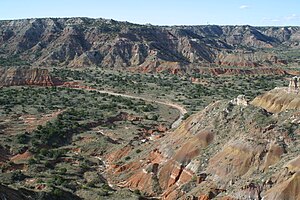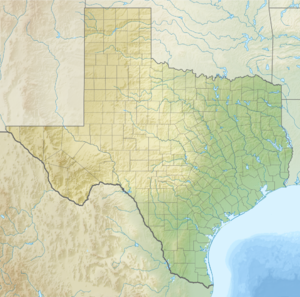Battle of Palo Duro Canyon
| Battle of Palo Duro Canyon | |||||||
|---|---|---|---|---|---|---|---|
| Part of the American Indian Wars | |||||||
 Palo Duro Canyon | |||||||
| |||||||
| Belligerents | |||||||
|
Tonkawa |
Cheyenne Comanche Kiowa | ||||||
| Commanders and leaders | |||||||
| Ranald S. Mackenzie |
Poor Buffalo Lone Wolf | ||||||
| Strength | |||||||
| 400 cavalry | 1500 warriors | ||||||
| Casualties and losses | |||||||
| 1 wounded[1]: 490 |
15 killed at Tule 50-60 killed at Palo Duro[1]: 494 | ||||||
Location within Texas | |||||||
The Battle of Palo Duro Canyon was a military confrontation and a significant
Background
Late in the summer of 1874, Quahada
Mackenzie formed three columns, the first column consisting of eight companies of the 4th Cavalry and two infantry companies, the second column under Lt. Col.
Early in September, Tonkawa[3] and Black Seminole Scouts in advance of the 4th Cavalry were ambushed by Comanche near the Staked Plains and escaped with their lives. The scouts relayed and alerted the Comanche position to Mackenzie.[4]
The battle

Early on the morning of September 28, two of Mackenzie's Tonkawa scouts found a "fresh trail" and Mackenzie resumed the march, reaching a "wide and yawning chasm" at dawn, where they could see the Indian lodges.[1]: 488 Mackenzie's cavalry dismounted and led their horses single-file along a narrow zig-zag path.[1]: 488
Mackenzie first hit Chief Lone Wolf's Kiowa camp and routed it.[3] Chiefs Poor Buffalo and Lone Wolf and the Indians managed to get away, leaving behind their possessions and horses, climbing up both sides of the canyon.[1]: 489 The Indian warriors began firing on the troops from 800–1000 feet above, making "it so hot", it prompted one to say, "How will we ever get out of here", to which Mackenzie stated, "I brought you in, I will take you out".[1]: 491 Part of the command started a retreat up the "precipitous cliffs" from which they had descended while others pulled down the lodges, chopped up the lodge poles, and burned all of the Indian belongings in huge bonfires.[1]: 493–493 Almost 2000 horses were captured and moved from the canyon with the remaining troops by 4 PM.[1]: 493 Mackenzie's troops made it back to their supply camp in Tule Canyon on the morning of the 29th.[1]: 494
Results
The loss of the Palo Duro camp meant the loss of the Indians' safe haven and all of their winter supplies. Some horses fled with the Indians onto the plains but Mackenzie was able to capture 1500-2000 ponies, which he slaughtered to prevent them from falling into the hands of the Indians.
See also
References
- ^ a b c d e f g h i j k l m n o p Carter, R.G., 1935, On the Border with Mackenzie, Washington D.C.: Eynon Printing Co.
- ^ Dillon, Richard H. (1983). North American Indian Wars
- ^ a b c Schilz, Thomas F. "Palo Duro Canyon, Battle of". Texas State Historical Association.
- ^ ISBN 9780842025867.
- ^ "Red River War-Battles". Texas Beyond History. University of Texas at Austin. Retrieved 2013-02-12.


